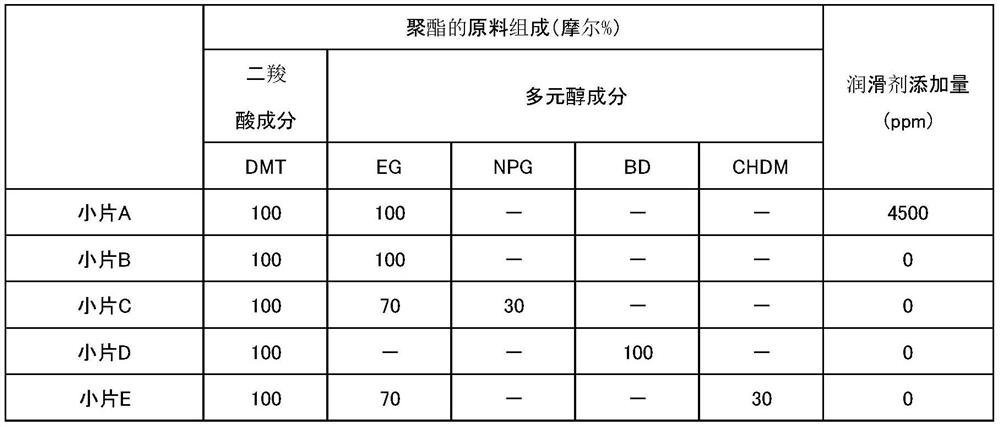Heat-shrinkable polyester-based film roll
A film roll, heat shrinking technology, applied in thin material processing, winding strip, application, etc., can solve the problems of low heat resistance, bad conditions, hydrogen chloride gas generation, etc., and achieve less core wrinkles and less trouble. Effect
- Summary
- Abstract
- Description
- Claims
- Application Information
AI Technical Summary
Problems solved by technology
Method used
Image
Examples
Embodiment
[0082] Next, the present invention will be specifically described using examples and comparative examples, but the present invention is not limited to the forms of the examples, and can be appropriately changed within a range not departing from the gist of the present invention.
[0083] The evaluation methods used in the present invention are as follows. In addition, unless otherwise stated, 1 m of film was removed from the surface layer of a film roll, and the film or film roll of the surface layer part after this removal was evaluated.
[0084] [Thermal shrinkage rate in the main shrinkage direction]
[0085] Cut the film into a square of 10cm×10cm, in hot water at a temperature of 90°C±0.5°C, treat it for 10 seconds under no load to shrink it, then measure the transverse direction (main shrinkage direction) of the film. For the size, the heat shrinkage rate was obtained from the following formula (1).
[0086] Thermal shrinkage rate = ((length before shrinkage - length a...
Synthetic example 1
[0109] Synthesis example 1 (synthesis of polyester)
[0110] In the esterification reactor, 57036 parts by mass of terephthalic acid (TPA), ethylene glycol (EG) of 33244 parts by mass, neopentyl glycol (NPG) of 15733 parts by mass, 23.2 parts by mass of polycondensation catalyst Antimony trioxide, 5.0 parts by mass of sodium acetate (alkali metal compound) and 46.1 parts by mass of trimethyl phosphate (phosphorus compound), adjust the pressure to 0.25MPa, and stir at 220-240°C for 120 minutes to perform esterification reaction. Return the pressure of the reactor to normal pressure, add 3.0 parts by mass of cobalt acetate tetrahydrate and 124.1 parts by mass of magnesium acetate tetrahydrate, stir at 240°C for 10 minutes, depressurize to 1.33hPa in 75 minutes, and raise the temperature to 280°C. Stirring was continued at 280° C. (about 70 minutes) until the melt viscosity became 4500 Poise, and then discharged into water in a strand form. The discharge was cut with a wire cu...
Synthetic example 2
[0112] Small pieces A and C having the compositions shown in Table 1 were obtained by the same method as in Synthesis Example 1. In the table, NPG is an abbreviation of neopentyl glycol, BD is an abbreviation of butanediol, and CHDM is an abbreviation of cyclohexanedimethanol. It should be noted that, in the small piece A, SiO was added as a lubricant at a ratio of 4500 ppm relative to the polyester. 2 (Fuji Silysia Ltd., Sylysia 266). The intrinsic viscosity is as follows: small pieces A, C, E are 0.73dl / g, small piece D is 0.92dl / g.
[0113] [Table 1]
[0114]
PUM
| Property | Measurement | Unit |
|---|---|---|
| length | aaaaa | aaaaa |
| thickness | aaaaa | aaaaa |
| thickness | aaaaa | aaaaa |
Abstract
Description
Claims
Application Information
 Login to View More
Login to View More - R&D
- Intellectual Property
- Life Sciences
- Materials
- Tech Scout
- Unparalleled Data Quality
- Higher Quality Content
- 60% Fewer Hallucinations
Browse by: Latest US Patents, China's latest patents, Technical Efficacy Thesaurus, Application Domain, Technology Topic, Popular Technical Reports.
© 2025 PatSnap. All rights reserved.Legal|Privacy policy|Modern Slavery Act Transparency Statement|Sitemap|About US| Contact US: help@patsnap.com



